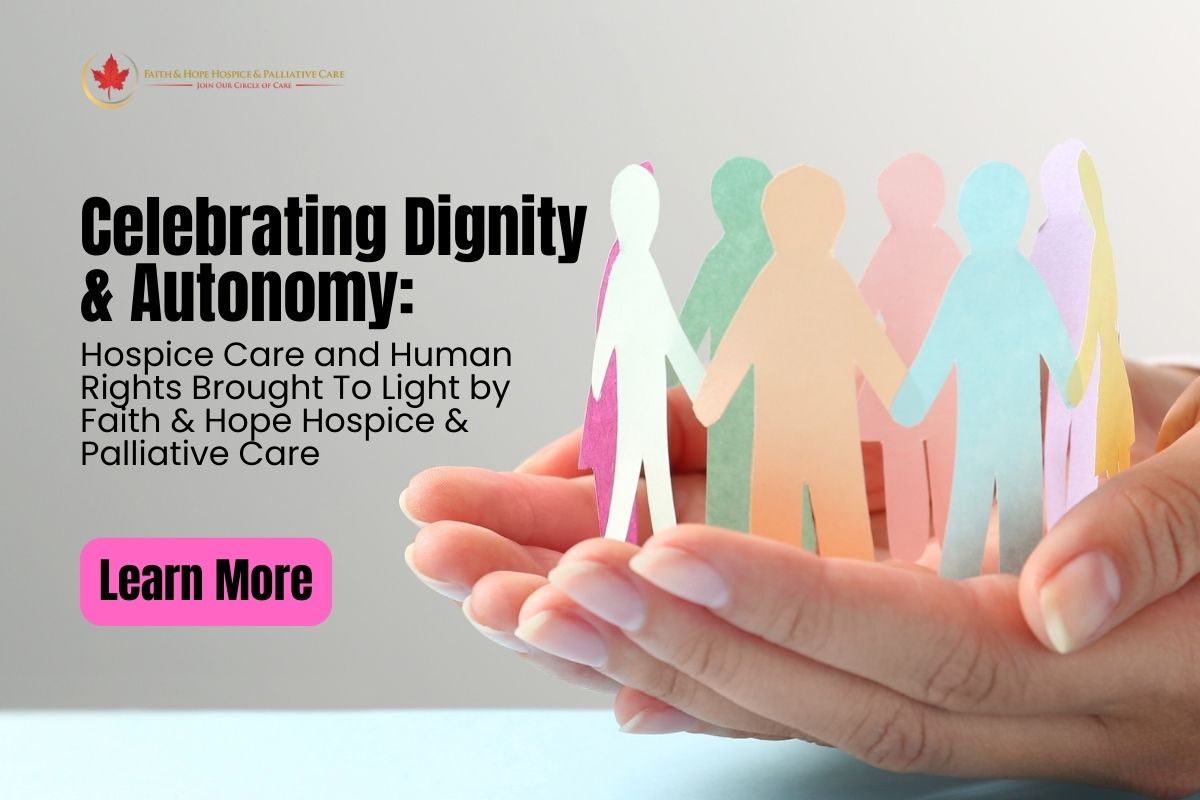
- By: administrator
- Blog
- No Comments
As we step into National Human Rights Month, let’s embark on a journey through the heart of hospice care with Faith and Hope Hospice. Let us discover how our dedicated team, serving Los Angeles hospice patients and beyond, weaves the values of dignity, respect, and patient autonomy into every facet of care we provide, aligning seamlessly with the spirit of each individual’s human rights.
Honoring Each Person’s Story: Dignity in Every Detail of Hospice Care
Faith and Hope Hospice is a beacon of dignity in hospice care, valuing each patient as a unique person with a rich history. From the first hello, we embrace the essence of who our patients are, offering compassionate care that recognizes and upholds the inherent dignity of every individual. It’s not just a principle at Faith and Hope; it’s a daily commitment woven into the fabric of care we provide.
Empowering Choices: Patient Autonomy in the Spotlight
For Faith and Hope Hospice, patient autonomy takes center stage. Our Los Angeles hospice care professionals collaborate with our patients and their families, ensuring that every decision, from treatment plans to end-of-life choices, reflects each of our patient’s wishes. It’s an empowering journey guided by the belief that every patient has the right to actively shape their care, finding strength in us as their hospice caregivers.

Celebrating Diversity: Cultural Competence as a Human Right
Diversity is a cornerstone at Faith and Hope Hospice, where cultural competence is not just practiced but celebrated. The hospice care team respects diverse backgrounds, traditions, and beliefs, creating an inclusive space where everyone feels understood and valued. It’s about fostering an environment that honors every person’s unique experiences and histories.
Equal Care for All: A Human Rights Imperative in Hospice
Faith and Hope Hospice upholds equality as imperative in the hospice care we give. We break down barriers, ensuring comprehensive care that is accessible to all, regardless of background or circumstance. It’s a commitment to justice and fairness in every aspect of hospice care delivery, where each patient receives the same high standard of compassionate attention from us as their caregivers.
Trust Through Transparency: Building Human Connections in Hospice Care
Effective communication at Faith and Hope Hospice is not just a tool; it’s the foundation of trust. Our hospice care professionals prioritize open and honest communication, keeping patients and families informed at every turn. By fostering transparency, Faith and Hope Hospice builds relationships founded on trust and mutual respect, ensuring every individual feels heard and understood.
Respecting Choices: A Human Rights Approach to End-of-Life Care
At Faith and Hope Hospice, supporting patients in expressing their end-of-life wishes is a cornerstone of care. From planning discussions to honoring living wills, our hospice care team facilitates these conversations with empathy, ensuring individual choices lead the way. It’s a human rights approach that respects and cherishes the autonomy of each of our patients.
Addressing Disparities: Advocating for Human Rights in Hospice
Faith and Hope Hospice actively addresses disparities in healthcare, working towards equitable access for all. We advocate for change and foster community engagement to ensure that every patient receives the same level of compassionate care. It’s an ongoing commitment to creating a more just and compassionate healthcare landscape.
Educating Advocates: Hospice Care as a Beacon of Human Rights Awareness
In the context of National Human Rights Month, Faith and Hope Hospice serves as an advocate and educator. By raising awareness about human rights principles, our team can contribute to a broader societal understanding of dignity, autonomy, and equality. It’s a ripple effect that extends beyond healthcare settings, creating a compassionate and just world.
In Conclusion: Upholding Human Dignity in Hospice Care with Faith and Hope
National Human Rights Month invites reflection on the connection between hospice care and the fundamental principles of human rights, especially when guided by the dedicated team at Faith and Hope Hospice. It’s a celebration of compassionate care that recognizes the intrinsic worth of every individual, fostered by care that centers on dignity, autonomy, and equality. Join us in honoring the essence of human rights in hospice care, where Faith and Hope Hospice’s actions are a testament to the belief that every person deserves to be treated with respect, compassion, and the utmost regard for their inherent human dignity.
Join the Journey: Experience Dignified Hospice Care
If you or a loved one are seeking dignified hospice care, we invite you to join the journey with Faith and Hope Hospice. Dial (626) 869-2151 to connect with the best hospice care provider in Los Angeles. Experience a level of care where every person is treated with profound respect, compassion, and the utmost regard for their inherent human dignity.
Faith and Hope Hospice: Your Partner in Compassionate Care
Faith and Hope Hospice goes beyond providing care; we become partners in your journey, ensuring that every step is guided by the principles of human rights. Make the choice for unparalleled hospice care – where your dignity is cherished, your autonomy is honored, and equality is the foundation of compassionate support. Call (626) 869-2151 to experience the highest standard of hospice care with Faith and Hope Hospice.
